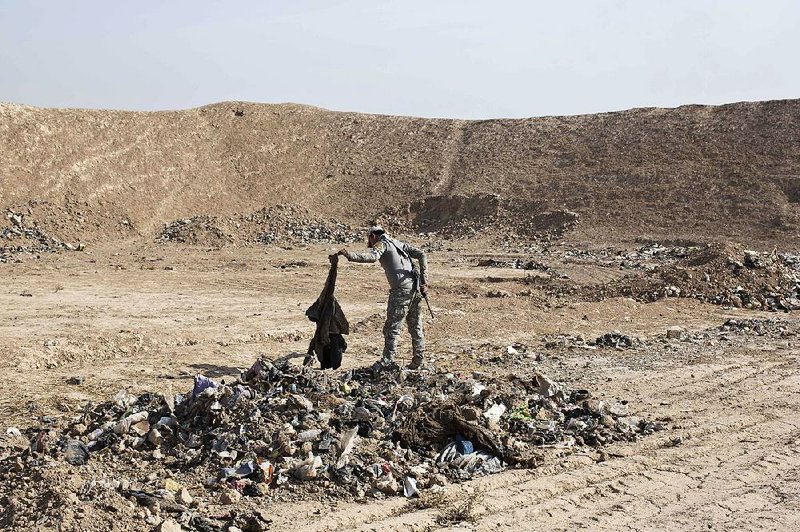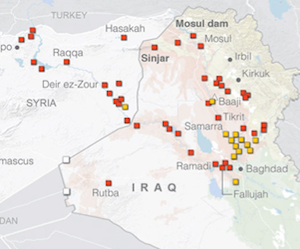BASHIQA, Iraq -- New reports emerged Friday of public killings and other atrocities committed against Mosul residents by Islamic State militants, including dozens of civilians whose bullet-riddled bodies were hung from utility poles after they were accused of using cellphones to leak information to Iraqi security forces.
The United Nations human-rights office said Islamic State fighters killed 70 civilians in Mosul this week, part of a series of abuses to come to light in recent days, including torture, sexual exploitation of women and girls, and use of child soldiers who were filmed killing civilians.
The revelations are the latest reports of Islamic State brutality as the group retreats into the dense urban quarters of Iraq's second-largest city, forcing the population to go with them as human shields.
In its report, the U.N. human-rights office in Geneva said Islamic State fighters shot and killed 40 people on Tuesday after accusing them of "treason and collaboration," saying they communicated with Iraqi security forces by cellphone. The bodies, dressed in orange jumpsuits, were hung from power poles in Mosul.
A day later, the extremists reportedly shot to death 20 civilians at a military base. Their bodies were hung at traffic intersections in Mosul, with signs saying they "used cellphones to leak information."
Video posted by the militants on Wednesday showed four children, who appear to be 10 to 14 years old, shooting four civilians accused of disloyalty at a location near the Tigris River, said Ravina Shamdasani, a spokesman for the U.N. human-rights office. The video release identified one of the children as Russian, another as coming from Uzbekistan and two as Iraqis.
"They are showing they are still in business," Shamdasani said of the Islamic State, also known as ISIS.
A Mosul resident, reached by telephone, said crowds have been watching the killings in horror. One victim was a former police colonel, he said.
As the army advances, Islamic State militants have been rounding up thousands of people and killing those with suspected links to the security forces. Soldiers last week discovered a mass grave in the town of Hamam al-Alil, 12 miles south of Mosul, containing some 100 bodies.
At the same time, the militants have gone door-to-door in villages south of Mosul, ordering hundreds to march at gunpoint into the city. Combat in Mosul's dense urban areas is expected to be heavy, and the presence of civilians will slow the army's advance.
Islamic State militants have boasted of the atrocities in grisly online photos and video. The United Nations has urged authorities to collect evidence of Islamic State abuses of civilians to use in eventually prosecuting the militants in tribunals.
Town Booby-Trapped
Iraqi troops are advancing from four fronts on Mosul, the last major Islamic State holdout in Iraq. As Iraqi special forces battle in eastern neighborhoods of the city, Kurdish peshmerga forces are holding a line north of the city, while Iraqi army and militarized police units approach from the south. Government-sanctioned Shiite militias are guarding western approaches.
In the formerly Islamic State-held town of Bashiqa, northeast of Mosul, Kurdish commander Gen. Hamid Effendi said his forces were working to secure the area but faced booby traps that were holding up the advance.
More than a thousand unexploded bombs are believed buried in Bashiqa, Effendi said. More than 100 Islamic State fighters have been killed in combat, he said, but wounded fighters likely remain in defensive tunnels built by the militants.
On Friday, teams went building by building into the night detonating explosives left behind in Bashiqa, which was deserted except for a few residents trickling in to check on their homes and businesses.
Among them was 60-year-old Khan Amir Mohammed, who discovered that his home had been turned into a mortar post by the militants, who dug seven tunnels on his family's 3½-acre property before retreating.
A nearby shop where Mohammed sold animal feed had collapsed from an apparent airstrike.
"What can I say? I feel powerless," he said, surveying the destruction.
Down the road, Kurdish forces were detonating bombs left behind by the militants. First Sgt. Ayub Mustafa said his unit alone had disabled about 250 bombs, the vast majority homemade explosives.
"Apparently they have a smart electrician with them. They're well-made," he said.
Special forces troops entered the Qadisiya neighborhood of Mosul on Friday, exchanging small-arms and mortar fire with Islamic State positions and advancing slowly to avoid killing civilians and being surprised by suicide car bombers, said Brig. Gen. Haider Fadhil.
Regular army troops control 90 percent of the Intisar neighborhood, said one officer, but progress has slowed because "the streets are too narrow for our tanks."
Destruction at Airport
Newly published satellite images also reveal the Islamic State's efforts turning the group's Iraqi capital into a fortress in preparation for Iraqi liberators.
The new photos show the results of a mammoth undertaking to dismantle the city's airport, an effort apparently intended to prevent Iraqi and coalition forces from using the facility as a staging ground. The images show dozens of trenches dug into the concrete runways, rendering them useless for fixed-wing aircraft, along with rubble piles that were once hangars and terminal buildings.
"The airport has been nearly erased from existence," said an analysis released Thursday by Stratfor Forecasting, a private intelligence and consulting firm that provided the satellite images. The analysis described the airport's dismantling as a part of a "scorched earth" campaign intended to slow the advance of the Iraqi and Kurdish forces now fighting their way through Mosul's southern and western outskirts.
While seizing the airport normally would be considered a primary objective for the Iraqi army, Mosul's airport is "now essentially worthless as an asset for attacking forces," the Stratfor analysis said.
Meanwhile, the U.N. cited new evidence the militants have used chemical weapons, escalating fears the Islamic State will resort to chemical warfare to try to hold on to the city, still home to more than a million people.
Shamdasani told reporters in Geneva that four people died from inhaling fumes after the Islamic State shelled and set fires to the al-Mishrag Sulfur Gas Factory in Mosul on Oct. 23.
Shamdasani said reports indicated that the Islamic State has stockpiled large amounts of ammonia and sulfur and placed them near civilians.
Voicing anger at the "numbing and intolerable" suffering inflicted on civilians by the unfolding conflict, the U.N. human-rights chief, Zeid Raad al-Hussein, in a statement on Friday demanded immediate action by the Iraqi government to protect fleeing or freed residents of areas held by the Islamic State and to bring the attackers to justice.
U.N. officials say about 48,000 people have now fled Mosul since the government campaign began on Oct. 17.
Information for this article was contributed by Adam Schreck, Brian Rohan, Qassim Abdul-Zahra, Jamey Keaten and Susannah George of The Associated Press; by Joby Warrick of The Washington Post; and by Nick Cumming-Bruce and Tim Arango of The New York Times.
A Section on 11/12/2016

